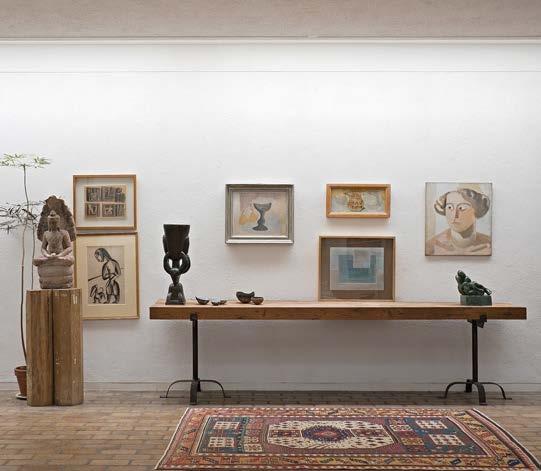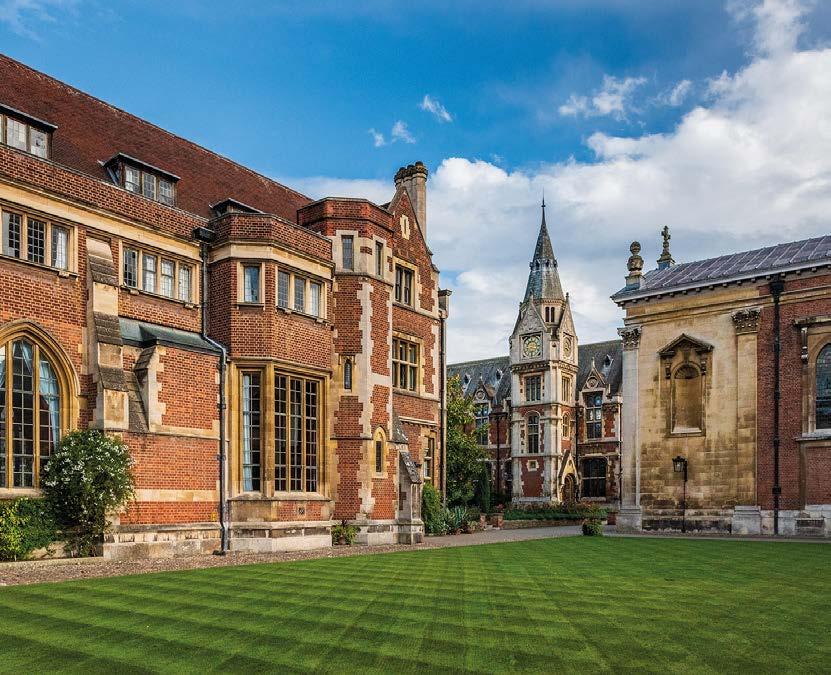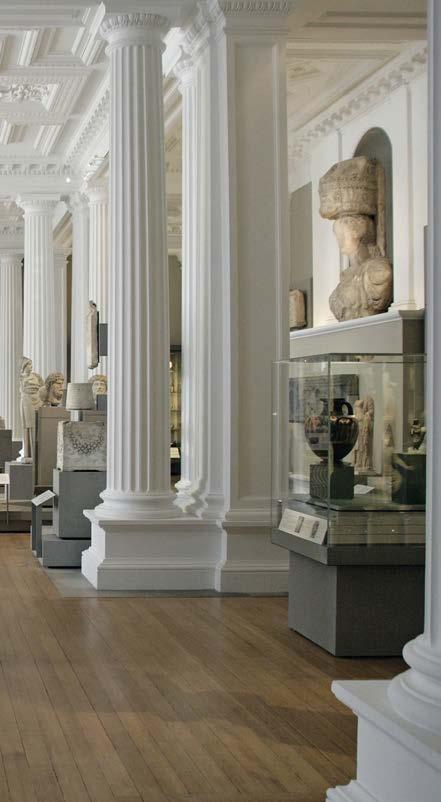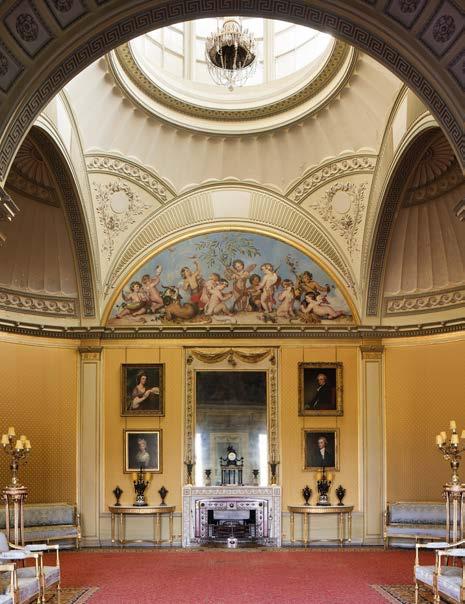
5 minute read
CITY GUIDE: CAMBRIDGE
TOP 10 CAMBRIDGE
Great minds and beautiful architecture meet in the historic university city
WORDS NATASHA FOGES
Colleges, cobbles and punting on the Cam – as university towns go, Cambridge is a fine specimen. Founded in 1209, Cambridge University is the second oldest in the English-speaking world (after Oxford), and many of the colleges are palatial. Aside from academia, the museums and gardens are world-class, and the quota of bookshops and bicycles imbues the town with the nostalgia of a bygone age.
These days Cambridge is inextricably linked with its academic status, but before the first students arrived, this Fenland town, with its easy access by river, was a busy trading centre. Once the university was established it became equally well-known as a place of learning, and soon students were arriving in large enough numbers to set up hostels under masters, forerunners of the colleges.
The 31 colleges give the town its unique distinction, from Peterhouse, founded in 1284, to the newest, Robinson, opened in 1977; many are so grand that they could pass for stately homes. Almost all can claim eminent graduates, including more Nobel prize winners than any other university: poets John Milton, William Wordsworth, Lord Byron, Samuel Taylor Coleridge and Ted Hughes; numerous politicians, including Oliver Cromwell, leader of parliamentary forces in the English Civil War; and scientists Isaac Newton, Francis Crick and Charles Darwin.
Each of the colleges has a distinct feel, and students and alumni are loyal to their own. Book a tour of the architectural highlights with a student or graduate (just don’t step on the lawns – a privilege reserved for fellows); or take the romantic route with a punt tour along the College Backs, enjoying a privileged view of colleges, sweeping lawns, historic bridges and trailing willows en route.

1Bridge of Sighs The most famous of Cambridge’s bridges is the covered Bridge of Sighs at St John’s College, based on the one in Venice and built in 1831. It has historically been a target for student pranksters, and has on two occasions had a car suspended from its arches. www.joh.cam.ac.uk
3King’s College Chapel The Gothic splendour of King’s College Chapel, where Oliver Cromwell trained his crew of Parliamentarians during the English Civil War, is not to be missed. Be sure to visit for choral evensong, when the incantatory rise and fall of fine voices is a tranquil way to end a day in Cambridge. www.kings.cam.ac.uk

MARCIN ROGOZINSKI/ROBERT EVANS/ALAN COPSON PICTURES/ALAMY/MICHAEL JONES/ © PHOTOS: THE FITZWILLIAM MUSEUM, CAMBRIDGE/TRINITY COLLEGE, CAMBRIDGE/CHRIS DORNEY/SHUTTERSTOCK
2Fitzwilliam Museum The grand pillared building of the Fitzwilliam holds displays ranging from Egyptian antiquities to Picasso and Monet. The collection is the endowment of a wealthy aristocrat, Richard, Viscount Fitzwilliam of Merrion, who travelled Europe in the early 19th century acquiring masterpieces and precious artefacts. www.fitzmuseum.cam.ac.uk



4College tours Each college has its individual history, some of it very royal: Henry VI founded King’s College; while Trinity was established by Henry VIII. Let a student or graduate show you around with Cambridge Alumni Tours, a highlight of which is the chance to enter beautiful Pembroke College. www.cambridgealumnitours.co.uk 5 Kettle’s Yard The light-filled former home of Jim Ede, a curator of London’s Tate Gallery, Kettle’s Yard holds an impressive contemporary art collection, with works by Brancusi, Miró and Hepworth. www.kettlesyard.co.uk




6Wren Library The Christopher Wren-designed library in Trinity College is a treat for bookworms, with treasures including a first edition of Darwin’s The Origin of Species, a Shakespeare First Folio and the original manuscript of Winnie-the-Pooh. www.trin.cam.ac.uk
7Punting along the Backs The Backs – the expanse of lawns and gardens behind the older, riverside colleges – offer a different perspective on these historic buildings. Take in the view from a chauffeured punt; Scudamore’s have been punting this stretch of the Cam since 1910. www.scudamores.com
8Cambridge Botanic Garden Created by John Henslow, botanist and mentor of Charles Darwin, the Botanic Garden is the perfect place to retreat from academia. Wander between glasshouses, woodland and stream gardens, before settling down for a picnic on the lawn. www.botanic.cam.ac.uk
9Wimpole Estate The largest house in Cambridgeshire, Wimpole Hall sits in a 2,500-acre estate eight miles southwest of Cambridge. Surrounding the 17th-century mansion is a Capability Browndesigned garden and parkland. It was once owned by Elsie Bambridge, the daughter of writer Rudyard Kipling. www.nationaltrust.org.uk

10 Grantchester This pictureperfect village sits on the river just before it enters Cambridge from the southwest. The war poet Rupert Brooke stayed here, and inspiration can still be found in its green meadows and river views, while the question “And is there honey still for tea?”, immortalised in Brooke’s poem ‘The Old Vicarage, Grantchester’, can be answered at the genteel Orchard Tea Garden. www.theorchardteagarden.co.uk


THE PLANNER
GETTING THERE Trains from London King’s Cross and Liverpool Street take about an hour. Grantchester is a pleasant 45-minute walk from Cambridge, or a short hop on the no.18 bus. www.thetrainline.com; www.stagecoachbus.com
WHERE TO STAY The best place to stay is the University Arms, which has been hosting visitors since 1834. Its rooms, painted in soothing Cambridge Blue, are cosied up with colourful textiles on headboards and ottomans, while elegant drapes frame views of Parker’s Piece (one of Cambridge’s most famous open spaces) or bustling Regent Street. There’s a distinct collegiate air, too, in the leather-padded writing desks, the curated selection of books and art, and the stripy hallway carpets, reminiscent of university ties. You can aspire to a Cambridge intellect in the panelled library, and free bike hire is available, so you can whizz around town like a local. www.universityarms.com
WHERE TO EAT AND DRINK The University Arms has an excellent restaurant, Parker’s Tavern, with big windows overlooking Parker’s Piece. It manages to evoke the feel of a wood-panelled Cambridge dining hall – minus the dons and gowns, and with added elegance. The brasserie-style menu concentrates on British dishes with a twist, in dishes such as honey and thyme slow roast Norfolk duck, and crispy coronation chicken salad.
For tea and cake, it has to be Fitzbillies, a Cambridge institution founded in 1920. Cambridge isn’t short of historic pubs; try The Eagle, thought to be the city’s oldest pub, where in 1953 scientists Francis Crick and James Watson announced that they had discovered the double helix structure of DNA (a plaque commemorates the event). www.parkerstavern.com; www.fitzbillies.com; www.greeneking-pubs.co.uk
i
FURTHER INFORMATION www.visitcambridge.org










